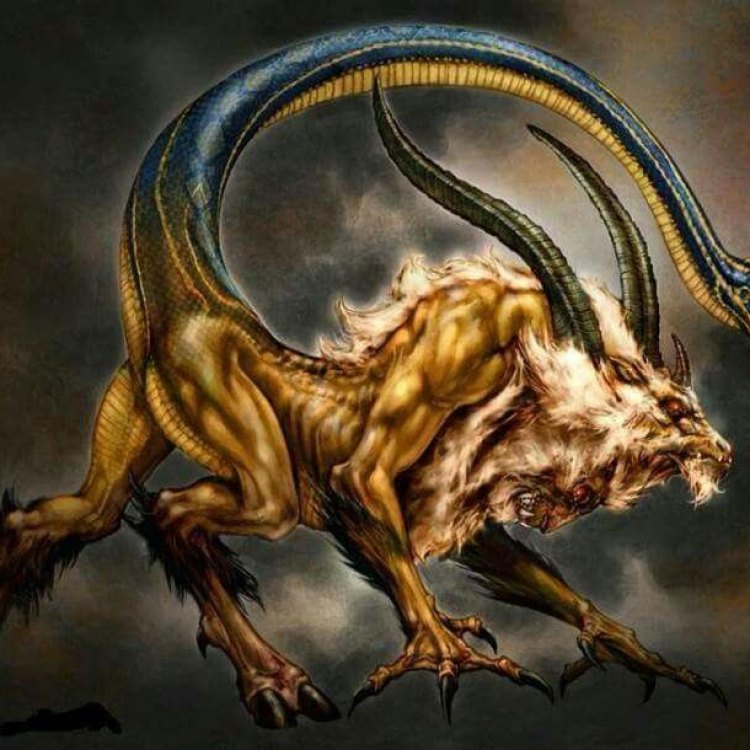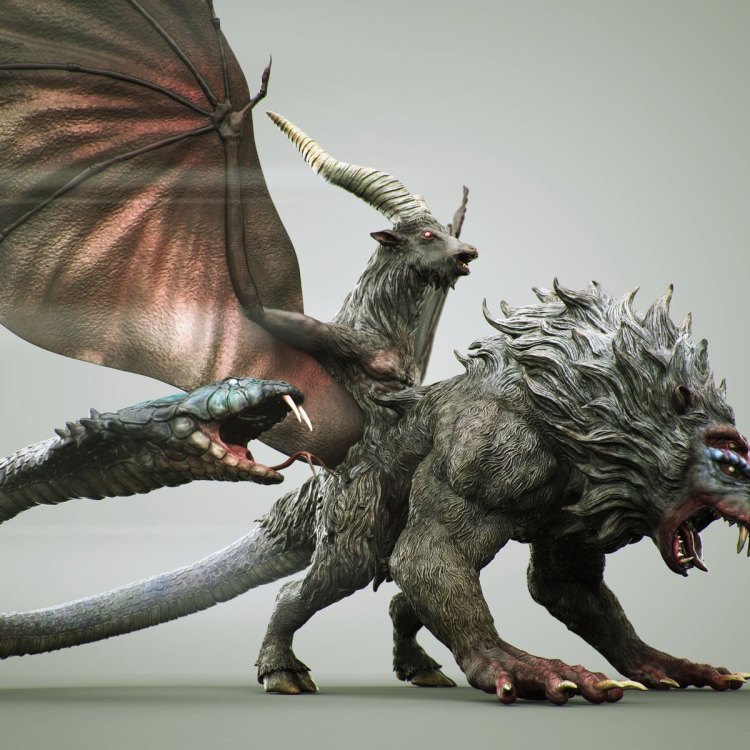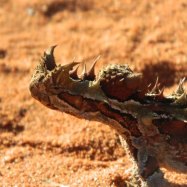
Chimaera
Up to 5 feet
The Chimaera, commonly known as ghost shark, is a fascinating deep-sea creature with an elongated body that can grow up to 5 feet in length. Belonging to the Chimaeridae family, it is a cousin to sharks and rays. Found in the depths of the ocean, it has earned the nickname ghost shark due to its elusive nature and pale appearance. #Chimaera #DeepSea #GhostShark
Animal Details Summary:
Common Name: Chimaera
Kingdom: Animalia
Habitat: Deep-sea
The Mystical Creature of the Deep Sea: Chimaera
Deep in the darkness of the ocean, lies a creature that seems to have emerged from a fairy tale. With its long tail, large eyes, and exotic coloration, the chimaera is a unique and fascinating creature that has captured the attention and curiosity of many. Despite its intriguing appearance, the chimaera remains an elusive and mysterious being, with much of its existence still cloaked in the secrets of the deep.Scientifically known as chimaera, this creature is also commonly referred to as ghost shark, rabbit fish, or rat fish Chimaera. Its name is derived from the Greek mythological creature, the Chimera, a fire-breathing monster with a lion's head, goat's body, and serpent's tail. Similarly, the chimaera is said to have the features of different animals, combining to create its own distinctive form.
Chimaeras belong to the animal kingdom, specifically the phylum Chordata, which includes all animals with a backbone. They are classified under the class Chondrichthyes, which also includes sharks, rays, and skates, and belong to the order Chimaeriformes. There are about 50 known species of chimaera, and they are all part of the family Chimaeridae.
The deep sea is the natural habitat of chimaeras, with most species found at depths of over 650 feet. They primarily inhabit temperate and tropical waters, and can be found worldwide, from the coasts of Africa to the depths of the Arctic Ocean. Due to their deep-sea lifestyle, chimaeras have a wide geographical distribution and can be found in all major oceans, from the Atlantic to the Pacific.
Given their elusive nature and deep-sea dwelling, there is limited information available about chimaeras Campine Chicken. They are primarily carnivorous, feeding on a variety of fish, crustaceans, and mollusks. Their feeding method is different from most fish, as they use their specialized upper jaws to grasp and crush their prey. This unique feeding method makes chimaeras well-suited for their deep-sea lifestyle, as they do not have to swim long distances to hunt for food.
One of the most striking features of chimaeras is their coloration, which varies from species to species. Some are grey, while others can have pink, blue, or even yellow hues. This variation in coloration also serves as a form of camouflage, allowing chimaeras to blend in with their deep-sea surroundings. Additionally, their elongated body shape allows them to maneuver easily in the water, making them efficient and agile predators.
Chimaeras can grow up to a length of 5 feet, with males generally being smaller than females. Despite their relatively small size, they are considered top predators in their deep-sea ecosystem, feeding on a variety of prey and defending their territory against other fish. They have also been known to defend themselves against larger predators, such as sharks, using their poisonous spines located on their dorsal fins.
One of the most fascinating characteristics of chimaeras is their ability to reproduce through a process known as oviparity. This means that instead of giving birth to live young, female chimaeras lay eggs that are fertilized internally, similar to birds. This feature is unique to chimaeras and sets them apart from other fish species.
Due to their deep-sea lifestyle, the impact of human activities on chimaera populations is relatively low. However, like many other marine creatures, they face threats such as habitat destruction, overfishing, and pollution. As deep-sea fishing continues to expand, chimaeras could potentially become vulnerable to accidental capture and bycatch.
Despite their limited exposure to humans, chimaeras have long been an object of fascination and awe. They have been featured in many myths and legends, and their mysterious appearance has captured the imagination of many. However, their enigmatic nature has also made them a subject of fear and superstition, with some cultures considering them bad omens or bringers of bad luck.
In recent years, there has been an increased interest in studying chimaeras, with scientists using advanced technology to explore the depths of the ocean and discover new species. This has led to a better understanding of their biology, behavior, and ecological role, shedding more light on this elusive creature.
In conclusion, the chimaera is a unique and captivating creature that has both intrigued and perplexed humans for centuries. Its deep-sea habitat, elusive nature, and distinctive appearance make it a subject of many myths and legends. However, as humans continue to explore and learn more about the vast depths of the ocean, we may uncover more about the secrets and mysteries of this remarkable creature.

Chimaera
Animal Details Chimaera - Scientific Name: Chimaera
- Category: Animals C
- Scientific Name: Chimaera
- Common Name: Chimaera
- Kingdom: Animalia
- Phylum: Chordata
- Class: Chondrichthyes
- Order: Chimaeriformes
- Family: Chimaeridae
- Habitat: Deep-sea
- Feeding Method: Carnivorous
- Geographical Distribution: Worldwide
- Country of Origin: Not applicable
- Location: Deep-sea
- Animal Coloration: Varies
- Body Shape: Elongated
- Length: Up to 5 feet

Chimaera
- Adult Size: Up to 5 feet
- Average Lifespan: Unknown
- Reproduction: Oviparous
- Reproductive Behavior: Not well documented
- Sound or Call: Not applicable
- Migration Pattern: Unknown
- Social Groups: Solitary
- Behavior: Slow-moving
- Threats: Habitat destruction, overfishing
- Conservation Status: Data Deficient
- Impact on Ecosystem: Ecologically important
- Human Use: Minor commercial fisheries
- Distinctive Features: Unique body shape, large head with a long snout
- Interesting Facts: Chimaeras belong to a group of ancient fish that diverged from sharks and rays around 400 million years ago.
- Predator: No major predators

Chimaera
Chimaera: The Elusive and Enigmatic Fish
Hidden deep in the depths of the ocean, lies a mysterious and elusive fish known as the Chimaera. With its unique body shape and ancient lineage, this fascinating creature has long captivated the minds of scientists and the public alike. In this article, we will delve into the world of Chimaeras and uncover the secrets of this enigmatic fish.Chimaeras, also known as ghost sharks or ratfish, are a group of cartilaginous fish that belong to the subclass Holocephali, which diverged from sharks and rays approximately 400 million years ago PeaceOfAnimals.Com. They are often referred to as "living fossils" because their body structure has remained relatively unchanged since the Paleozoic era.
One of the most distinctive features of the Chimaera is its unique body shape. Unlike other fish that have a streamlined body, Chimaeras have a bulky head with a long snout. They also have large eyes, a small mouth, and their gills are covered by a plate-like structure. Their body is covered in an armor of tough, smooth, and scaleless skin, giving them a ghostly appearance.
Chimaeras can grow up to 5 feet in length, making them one of the largest fish in the ocean. However, their size varies depending on the species and location. They can be found in the temperate and tropical waters of the Atlantic, Pacific, and Indian Oceans, living at depths of over 6,500 feet. Due to their elusive nature and deep-sea habitat, Chimaeras are rarely seen by humans, making them a mystery to many Common Toad.
The average lifespan of Chimaeras is still unknown, as they have not been extensively studied. However, it is estimated that they can live for several decades due to their slow growth rate and low metabolic rate. They are also solitary creatures, only coming together to mate.
Speaking of reproduction, Chimaeras are oviparous, meaning they lay eggs. However, the details of their reproductive behavior are not well documented as it is challenging to observe them in their natural habitat. Scientists believe that they lay their eggs on the ocean floor, and the eggs hatch into tiny larvae that look like miniature adult Chimaeras.
One of the most interesting facts about Chimaeras is that they have no major predators. Their tough skin and low metabolic rate make them an unattractive prey for larger animals. However, they are facing a more significant threat: human disturbance.
Habitat destruction and overfishing pose a significant threat to the survival of Chimaeras. Many species of Chimaeras are data deficient, meaning there is not enough information to assess their population status. However, it is believed that their population is declining due to the destruction of their deep-sea habitat and unintentional capture in fishing nets.
Despite their elusive nature and limited human use, Chimaeras play a crucial role in the ecosystem. They are scavengers, feeding on the carcasses of other animals and keeping the ocean floor clean. Due to their low reproductive rate, their extinction could have significant consequences for the balance of the ocean's delicate ecosystem.
From an economic standpoint, Chimaeras have a minor commercial value as their meat is considered a delicacy in some Asian countries. However, the demand for their meat is relatively low, and therefore, commercial fishing of Chimaeras is not widespread. But as with any species facing extinction, even minor commercial use can contribute to their decline.
The conservation status of Chimaeras is currently data deficient, mainly due to lack of information about their population size and distribution. However, several organizations and research teams are actively studying these mysterious creatures to gather data and create conservation efforts to protect them.
Chimaeras are named after a mythical Greek creature with the body of a lion, the head of a goat, and the tail of a snake. And just like the mythical creature, the Chimaera is an enigma, with a unique body shape and a lineage that dates back to millions of years. They are one of the few remaining links to the ancient underwater world and hold many secrets waiting to be uncovered.
Although their sound or call is not applicable, Chimaeras have a slow-moving behavior, which is necessary for their survival in the deep-sea environment. They glide through the water using their large, wing-like pectoral fins, making them efficient at conserving energy. They are also well adapted to the low oxygen levels found in deep waters, utilizing a unique respiratory system to extract oxygen from the water.
Chimaeras are also fascinating scientifically. As one of the oldest living groups of fish, they have a primitive brain structure that dates back to the Devonian period, making them valuable in evolutionary research. They also possess unique sensory organs that are unlike any other fish, allowing them to sense their environment in ways that scientists are still trying to understand.
In conclusion, Chimaeras are a unique and enigmatic fish that have captured the imagination of many. With their large head and long snout, they stand out in the ocean's depths, often being mistaken for alien-like creatures. But beyond their unusual appearance, Chimaeras are essential to the ocean's delicate ecosystem. As we continue to explore and study the depths of the ocean, we must also strive to protect and conserve this ancient and elusive fish.

The Mystical Creature of the Deep Sea: Chimaera
Disclaimer: The content provided is for informational purposes only. We cannot guarantee the accuracy of the information on this page 100%. All information provided here may change without prior notice.












